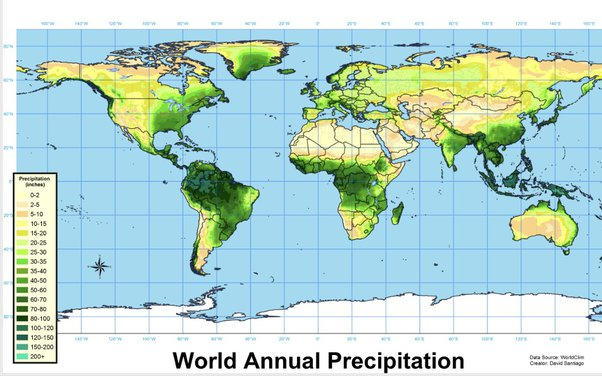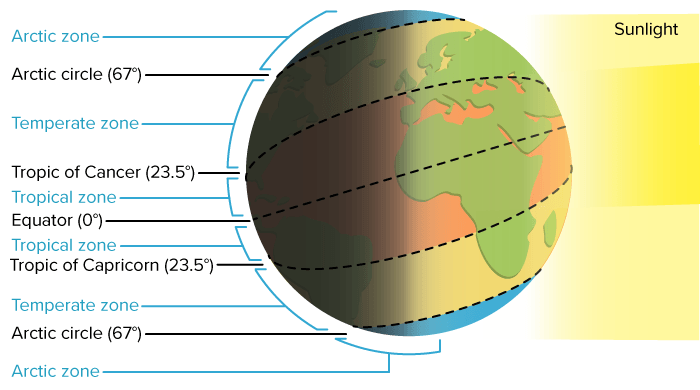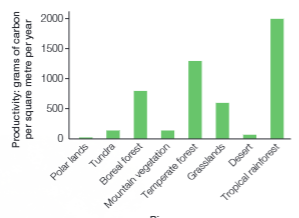Biomes - 93%
What are Biomes?
Biomes are large, distinct areas of the earth, with plants and animals that share similar characteristics as they have adapted to the features of the specific biome.
There are 11 main biomes: each with their own specific features and environments. These are:
Ocean
Coral Reefs
Freshwater rivers/lakes
Grasslands
Tundra
Mountain Vegetation
Polar Regions
Boreal Forests
Temperate Forests
Tropical Rainforests
Deserts
Biomes can be classified into two different types, terrestrial and aquatic. Terrestrial biomes are on land, whereas aquatic biomes are situated in the water. For example, Mountain Vegetation would be classified as a terrestrial biome, whereas the ocean would be classified as aquatic.
Examples
<———————————————————————————————>
Polar Region ————————————————————— Tropical Rainforest
-Low Temperatures/Rainfall ——————————————- High Temperatures/Rainfall
- Not perfect conditions for flora/fauna- ————————- Perfect conditions for flora/fauna
- Only 2 flowering species———————————————- Many species exist
- The largest land animal is a wingless fly
Biomes in relation to climate
The features of a biome (climate, weather, rainfall, soil) determine the amount of living things in the area. The climate clearly has an impact on the environment of a biome and the flora/fauna which lives there.
Note - Before understand the relationship between biomes and climate, it is crucial to understand the differences between climate and weather. Climate is a general ‘average’ of weather over a period of time, and generally patterns do not change. Weather, however, refers to the day to day changes in temperature, rain and wind.

 Within the areas where there is more sunlight; biomes that are hot appear. When it is cold however, such as near the Artic Circle, biomes that are cold will appear. Using these two maps: we can identify that Northern Africa is both hot and dry; creating a desert biome. While in areas such as South America, there is both high rainfall and high temperatures: creating tropical rainforests.
Within the areas where there is more sunlight; biomes that are hot appear. When it is cold however, such as near the Artic Circle, biomes that are cold will appear. Using these two maps: we can identify that Northern Africa is both hot and dry; creating a desert biome. While in areas such as South America, there is both high rainfall and high temperatures: creating tropical rainforests.
Biomes in Australia
Australia is an insanely large country, resulting in many different biomes across the country. The northern part of Australia is located in between the tropics, meaning that it will be closer to the equator, hence much warmer. The four main terrestrial biomes in Australia are;
Desert
Grasslands
Temperate Forests
Tropical Rainforests
Note - This is a study of biomes before Australia’s land was changed for human activities. Activities, such as farming: have resulted in changes to vegetation, land and water.
Forests
Forests are an important biome, hosting many of the worlds flora/fauna. Around 1/3 of Australia was covered in forest when colonists arrived. Now, much of this forest land has been converted into areas for farming. There are three types of forest: however only two of them can be found in Australia
Tropical Rainforests - Tropical Rainforest are mainly located between the Tropic of Cancer and the Tropic of Capricorn. Tropical Rainforests climate doesn’t generally change all year, with both a wet season (monsoon season) and a dry season. This climate is excellent for flora/fauna: meaning that tropical rainforest have the most biomass out of any other biome
Temperate Forests - Temperate forests are found in temperate climate, and can survive a much larger range of climates. Temperate Rainforest can be both hot and dry, or cool and moist. Temperate forest also cover much of Europe. Temperate forests actually contain more than 10% of the world’s pant species
Boreal Forests - Boreal Forests are typically found in the northern hemispheres and are made up of tall, generally evergreen trees. Boreal Forests can be found in countries like Canada, and are home to many of the world animal species as well. In Boreal Forests, there are normally longer winters and cooler locations.
Productivity of Biomes
The productivity of a biome is generally measured in biomass. Biomass is a term for everything in a biome that was once living, and also is living. This is done by identifying a small area, identifying anything that was once living, and then scaling that up to the area of the biome. Another method of calculating the productivity of a biome is to calculate the amount of carbon dioxide that the area uses minus the amount of carbon dioxide released.
 This graph is very important in understanding and applying the knowledge of productivity, climates and biomes in analyzation.
This graph is very important in understanding and applying the knowledge of productivity, climates and biomes in analyzation.
It is clear that Tropical Rainforest produce the most carbon. This is because of the ideal climate for both trees and animals to thrive in. However, the polar lands don’t produce a lot of carbon. This can be shown by the examples of polar regions earlier. There are NO flora to produce any carbon, due to the extreme temperatures, hence having a low carbon productivity and a low biomass.